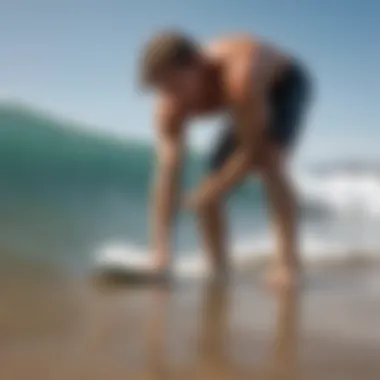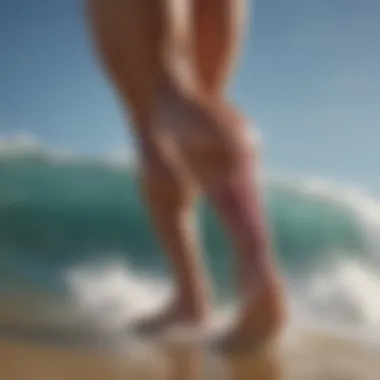Navigating Calf Cramps: Relief and Prevention Tips


Intro
Calf cramps can really throw a wrench in your plans, especially when you're out there riding the waves. Imagine being paddling out, feeling on top of the world, and then bang! You get hit with a cramp. Suddenly, you’re not just fighting the ocean; you’re twisting and turning with your leg screaming for a break. This isn’t just a small hiccup; it can disrupt not only your day of surfing but also your overall enjoyment of what should be a thrilling experience.
Understanding calf cramps, their causes, and how to deal with them is vital for anyone who spends considerable time on a surfboard. From seasoned surfers brushing up on their skills to beginners just starting out, knowledge about preventing and managing these uncomfortable occurrences can make a significant difference in your time on the water.
In this article, we'll dive deep into effective responses and practical strategies that surfboarders can use. We will also touch upon the physiological side of cramps, enhancing your awareness of what happens to your body. So, let’s roll up our sleeves and get to work on navigating these pesky cramps!
Surfing Techniques
Advanced Maneuvers for Experienced Surfers
For those who’ve spent considerable time on the surfboard, tackling advanced maneuvers not only boosts your confidence but can also put additional strain on your calves. Take, for instance, performing a late drop or executing a floater. These moves demand sudden bursts of power and might put more pressure on your muscle. If your calves aren’t conditioned properly, they may rebel. Concentrating on strengthening the calves through targeted exercises can make all the difference. The key is to build both strength and flexibility.
- Calf Raises: Simple yet effective, this exercise helps improve strength. Stand on a step and raise your heels to strengthen both the gastrocnemius and soleus muscles.
- Lunges: They not only work your legs overall but particularly target the calf muscles.
Beginner Tips for Catching Your First Wave
If you’re just starting with surfing, remember that calf cramps can pop up unexpectedly. A few precautions can keep those cramps at bay.
First off, choose a board that fits your size and skill level. A longer board often offers more stability, which is crucial when you’re learning. Practice in warm waters if possible, as they can ease muscle tension. Also, don’t underestimate the importance of a proper warm-up.
Also consider the following tips:
- Stay Hydrated: It can’t be overstated. Hydration affects muscle performance.
- Stretch Pre and Post Surfing: Simple stretches can prepare your muscles for the strain of paddling and riding.
- Listen to Your Body: Know when to take a break. Pushing through fatigue can lead to cramps.
"The body whispers before it shouts." This saying rings true for muscle-related issues, as often, cramping is a sign that you need to pay attention to your body’s signals.
Gear and Equipment Reviews
In-Depth Review of the Latest Surfboards
The choice of surfboard can exert a significant influence on your performance and can indirectly contribute to the likelihood of experiencing cramps. Certain boards, particularly those designed for specific styles or conditions, can either enhance or hinder your ability to maneuver.
When selecting a surfboard, consider the type of waves you’ll be riding. Longboards are generally more forgiving for beginners but may not facilitate advanced techniques as effectively as shortboards or fish boards.
Essential Accessories Every Surfer Should Have
Apart from a solid board, wearing the right gear is crucial. An ankle strap that keeps the board tethered to you can prevent sudden swims that might end up in more cramping. Rash guards that provide muscle compression can also play a role, improving blood flow and reducing muscle fatigue. Further, investing in a good wetsuit keeps your muscles warm, reducing the chances of tightening up mid-surf.
In summary, understanding how to navigate calf cramps is more than just knowing how to alleviate the pain when it hits. By strategically enhancing your surfing techniques and choosing the right gear, you’re setting yourself up for a more enjoyable experience on the waves, free from the uncomfortable interruptions of calf cramps.
Prolusion to Calf Cramps
Calf cramps are not just a mere annoyance; they can signal deeper underlying issues, especially for those involved in physically demanding activities like surfing. Many practitioners encounter this discomfort without even realizing the full ramifications of a cramp. Understanding calf cramps is crucial for surfboarders not only for immediate relief but also for long-term well-being and performance.
The importance of this topic stems from the reality that calf cramps can occur at the most inconvenient times—while riding a wave, for instance. Identifying the physiological basis for these cramps may offer insight into the coping strategies that follow. It's paramount to explore what goes on within the muscles during a cramp, as this knowledge can pave the way for effective responses and preventive measures.


Moreover, anecdotal evidence and conversations among surfboarders often highlight the repetitive nature of this issue. Engaging in surfing without fully addressing the cramping phenomenon could diminish an individual's experience, even making one hesitant to take on new challenges on the wave.
It's beneficial for surfers to recognize that calf cramps are not solely about muscle fatigue. Factors such as hydration, nutrition, and even psychological preparedness contribute significantly. Thus, this article seeks to delve into both the immediate responses and preventive strategies around calf cramps, equipping surfers with tools to manage and alleviate these disturbances.
In sum, understanding calf cramps is integral for anyone hitting the waves. By shedding light on the triggers and responses of calf cramps, we aim to create a smoother surfing experience, allowing riders to focus on the thrill of the surf rather than succumbing to unexpected discomforts.
Understanding Calf Cramps
Understanding calf cramps is crucial for anyone engaging in physically demanding pursuits, particularly surfboarders who rely heavily on their legs for balance and power while riding the waves. Recognizing the intricacies of calf cramps not only offers insights into why they occur but also aids in developing effective strategies for relief and prevention.
Muscle cramps are often a painful reminder of our body’s limits, and calf cramps can be particularly distressing due to their sudden onset. They can sabotage even the most exhilarating surfing session, leaving you grappling with discomfort that distracts from the thrill of the sport. By understanding the underlying principles of these cramps, you gain a more robust toolkit for managing them should they arise.
Physiology of Muscle Cramps
Muscle cramps occur when the muscle involuntarily and forcibly contracts. For calf cramps, this typically involves the gastrocnemius and soleus muscles, which work together to facilitate movement. When the neurons controlling these muscles become overly excited—often due to fatigue or dehydration—spontaneous contractions occur.
Several physiological factors may contribute to this phenomenon:
- Electrolyte Imbalance: Sodium, potassium, and magnesium play vital roles in muscle function. A deficiency in these electrolytes can disrupt normal muscle contraction and relaxation cycles.
- Muscle Fatigue: Extended periods of activity without proper rest can lead to muscle fatigue. As the muscles tire, they become more susceptible to cramping.
- Insufficient Blood Flow: During strenuous activity, blood flow to the muscles can become restricted. Insufficient circulation hampers the delivery of oxygen and nutrients, leading to increased cramping risk.
"Recognizing that calf cramps are essentially a signal from the body can empower you to take proactive measures against them."
Common Triggers of Calf Cramps
Calf cramps don’t just happen out of the blue; they often result from specific triggers that many people might overlook. Being mindful of these triggers can play a vital role in prevention strategies. Here are some commonly noted causes:
- Dehydration: Insufficient fluid intake can quickly set the stage for muscle cramps. Whether it's forgetting to hydrate before hitting the waves or not drinking enough during an intense surf session, dehydration is a common culprit.
- Overexertion: Surfing for extended durations without breaks can be a recipe for disaster. Pushing your limits without proper conditioning can invite cramps.
- Cold Weather: Cold temperatures can cause muscles to tighten and cramp more easily than in warmer conditions. Not warming up adequately in cooler climates can increase the chance of experiencing cramps.
- Inadequate Stretching: Failing to stretch before and after physical activities can leave muscles tight and prone to cramping.
- Poorly Fitted Footwear: Shoes that don’t fit well can affect muscle function and coordination, leading to cramps while surfing.
By understanding the physiology behind these cramps and identifying common triggers, you can take more informed steps to mitigate the risks associated with calf cramps. Whether it’s a matter of adjusting your hydration habits, improving your warm-up routine, or listening to your body’s signals, the knowledge gained in this section is foundational for managing cramps effectively.
Immediate Response to a Calf Cramp
When a calf cramp strikes, it feels like a bolt from the blue, catching you off-guard. Immediate response is crucial not only to alleviate the pain but also to prevent the situation from escalating. Recognizing the symptoms swiftly can make a world of difference, allowing the affected individual to take appropriate measures. Ignoring the initial discomfort or delaying action can lead to prolonged agony and even hinder performance, especially for those deeply involved in physically demanding activities like surfing.
Engaging with immediate response strategies lays the groundwork for effective pain management and recovery. It teaches you how to calm the storm of muscle spasms and prepare for a quick return to the water.
Recognizing the Symptoms
Recognizing that you’re experiencing a calf cramp requires a keen sense of bodily awareness. Most often, the initial signs include a sudden, sharp pain that might feel like a tight band constricting around the muscle. You might notice your calf muscle visibly twitching or hardening, and it can last anywhere from seconds to several minutes.
When dealing with a calf cramp, it’s essential to identify these symptoms right away. Many surfers might brush off the discomfort, thinking it’s just fatigue, but understanding you’re dealing with a cramp can change the game. Any misinterpretation could lead to overlooking necessary treatments.
Initial Actions to Take
When a calf cramp hits, timing is everything. Here’s what to do:
- Stretching Techniques:
It’s one of the first remedies to consider when grappling with a calf cramp. Gently stretching the affected muscle can help restore its natural length and reduce tightness. One common method is to stand facing a wall, placing your hands against it, and stepping back with the cramping leg. This stretches the calf muscles and encourages them to relax.
Stretching is not only effective but also popular among athletes due to its accessibility. You don’t need intricate setups or special equipment—just your own body and some patience. However, take care not to overdo it; too aggressive of a stretch can lead to further strain. - Massage Approaches:
Massaging the affected calf can also provide relief. Using your fingers, apply gentle pressure to the cramped area, gradually kneading the muscle and encouraging it to loosen up. This method can increase blood flow to the area, promoting faster recovery. Massage techniques shine in their versatility. You can do it yourself, or have someone help you out. But be mindful of how much pressure you apply; a too-significant push can intensify the discomfort.


Using Heat and Cold Therapy
After addressing the immediate pain, applying heat or cold can be beneficial in managing any residual discomfort. Cold packs can help reduce inflammation and numb the sharp pain, while heat works wonders by increasing blood flow to speed up healing. It’s essential to find what works best for you, as some surfers might prefer one over the other.
In the end, recognizing the symptoms and employing effective immediately responses to calf cramps is essential to maintaining overall performance and comfort. By being ready for whatever your calves throw your way, you can keep your surfing experience seamless and enjoyable.
Preventive Measures Against Calf Cramps
Calf cramps can sideline even the most dedicated surfboarders. Taking proactive steps to prevent these painful incidents can greatly enhance performance in the water and make for a more enjoyable experience overall. Understanding the significance of preventive measures is crucial, not only for avoiding cramps but also for maintaining overall muscle health. Every surfer should keep in mind that while they may not always be able to predict when a cramp might strike, they can certainly pave the way for reducing the likelihood of an occurrence through thoughtful strategies.
Hydration Strategies
Staying hydrated is like oiling the gears of a well-tuned machine. The human body relies heavily on water to function, especially during strenuous activity like surfing. When the body becomes dehydrated, muscle cramps can emerge as a troublesome byproduct. Aim to consume adequate fluids before, during, and after your time on the waves. Water is essential, but incorporating electrolyte-rich drinks, especially those containing sodium and potassium, can take hydration a step further.
- Pre-Surf: Drink at least 16 to 20 ounces of water about an hour before hitting the waves.
- During the Session: Keep a water bottle nearby, sipping on it throughout your session.
- Post-Surf: Replenish lost fluids immediately after; consider a sports drink to replace lost electrolytes.
"Staying hydrated isn’t just wise; it’s essential for peak performance and cramp prevention."
Nutritional Considerations
What you put into your body matters just as much as how much you drink. A well-balanced diet filled with vitamins and minerals supports muscle function and can ward off those pesky cramps. Particularly, nutrients like magnesium, calcium, and potassium work together to maintain muscle contractions and relaxation effectively.
- Fruits & Veggies: Include bananas, avocados, and leafy greens in your meals.
- Protein Sources: Lean meats and legumes provide the building blocks for muscle recovery.
- Snack Wisely: Grab a handful of nuts pre-surf; they’re not only easy to pack but also nutritionally dense.
Importance of Proper Warm-Up
A proper warm-up routine can be likened to the boiler room of a ship; it keeps everything running smoothly under pressure. Before jumping onto your board, focusing on warming up can significantly increase blood flow to the muscles, making them more pliable and less likely to cramp. Take about 10 to 15 minutes to do dynamic stretches, aiming for movements that mimic surfing motions. Here are some effective actions:
- Leg swings to loosen hip and calf muscles.
- Light lunges to stretch the front and back of your legs.
- Calf raises to prepare your muscles for exertion.
Consistent Strengthening Exercises
Regularly engaging in exercises that build leg and calf strength can bolster resilience against cramps. A stronger muscle is less prone to spasms, making it vital to incorporate both strength training and flexibility exercises into your weekly regimen. This could look like:
- Calf Raises: Standing on the edge of a stair and lowering your heels to the point of stretching.
- Resistance Band Workouts: Strengthening the calf muscles with the aid of bands supports flexibility and strength.
- Yoga or Pilates: Both focus on improving stability and flexibility, ultimately enhancing muscle conditioning.
By implementing these preventive measures against calf cramps, surfboarders can significantly decrease the likelihood of such discomfort. It’s about laying a foundation that supports your body through its movements in the surf.
Lifestyle Adjustments to Reduce Cramping
When surfers hit the waves, they often focus on the thrills and techniques of the sport, but the importance of lifestyle adjustments is often overlooked. These adjustments aren't just minor tweaks; they can be a game changer in how your body responds during and after surfing. Implementing smart choices regarding daily habits can dramatically lower the occurrence of calf cramps.
Ergonomics in Surfing Practices
Ergonomics refers to designing your activities and environment to fit your body's natural movements, which is crucial when surfing. A proper stance can alleviate unnecessary strain on your calf muscles. Here are some considerations to optimize your ergonomics:
- Body Positioning: Maintain a low center of gravity when riding the board. Bend your knees and keep your feet shoulder-width apart. This positioning helps distribute weight evenly and reduces muscle fatigue.
- Balance and Stability: Work on your balance through exercises that mimic surfing movements. Yoga or balance board training can enhance your proprioception, allowing your body to react better when navigating waves.
- Switch It Up: Regularly practice on both your dominant and non-dominant foot. This not only balances muscle development but also reduces the risk of overuse injuries including cramps.


By focusing on ergonomics, surfers can alleviate mechanical stress on the calves, resulting in a more enjoyable riding experience.
Footwear Considerations for Surfboarders
Believe it or not, the footwear you choose can significantly impact your surfing comfort and performance. Here’s how to select footwear that supports your calves:
- Supportive Footwear: Whether you're scurrying across rocky shores or walking long distances on the sand, proper shoes can prevent foot and calf strain. Look for shoes with arch support and cushioning to provide stability.
- Fit and Flexibility: Shoes should snugly fit without cramping your toes or arches. Having the right fit prevents blisters, which can lead to compensatory movements that stress the calves.
- Material Matters: Stick to materials that breathe well and allow for airflow. Wet feet can lead to increased slippage inside shoes, forcing your calves to engage more than necessary on uneven terrain.
- Barefoot Benefits: Depending on the weather and surf conditions, sometimes going barefoot can strengthen foot and calf muscles. Just make sure your environment is safe and not littered with sharp objects!
By minding footwear choices and applying proper ergonomic principles, surfers can ensure they are not only riding the waves but doing so without the pain and limitations that calf cramps can bring.
"A small change in your daily practices can lead to significant improvements in your performance and comfort. Treat your body right, and it will return the favor."
In sum, these lifestyle adjustments can make a world of difference. Not only do they reduce the chances of calf cramps, but they also enhance overall performance, enabling every surf session to be more enjoyable.
Psychological Aspects of Coping with Pain
Understanding the psychological aspects of coping with calf cramps is essential for surfboarders. Pain isn’t just a physical sensation; it can affect mental well-being and overall performance in the water. When a calf cramp strikes, the mind often spirals into a state of panic, potentially heightening the discomfort. Learning to manage these feelings can pave the way for a smoother experience.
Understanding Pain Perception
Pain perception varies from person to person, influenced by numerous factors including past experiences and mental state. In the case of a calf cramp, it is crucial to recognize that your mind can amplify or reduce the sensation. Those who have faced cramping before might be more anxious about it happening again, leading to a heightened perception of pain. This is not unfounded. Studies show that anxiety can double the perception of pain. Understanding this relationship is the first step in managing it effectively.
A few key factors influencing pain perception include:
- Cognitive appraisal: How you interpret the pain, whether as a threat or a benign signal, plays a significant role.
- Emotional context: If you're stressed or anxious, you’re likely to interpret pain as more severe.
- Previous experiences: Unpleasant past experiences with pain can create a fear response, resulting in greater pain sensitivity.
By acknowledging these elements, surfboarders can learn to separate the physical manifest from the psychological narrative surrounding the injury or discomfort.
Mental Preparation for Physical Activities
Mental preparation is a crucial component of successfully navigating physical challenges, including dealing with calf cramps while surfing. Visualization techniques can be highly beneficial. Imagine yourself riding the waves with ease, pain-free despite the challenges. Effective mental strategies include:
- Setting clear intentions: Before you hit the waves, set a positive intention focusing on your performance and enjoyment rather than potential pain.
- Mindfulness techniques: Being present in the moment helps to manage distractions and anxiety. Focus on your breathing to ground yourself when cramped.
- Building resilience: Develop a positive self-talk routine. Phrases like "I am strong" or "I can handle discomfort" can boost your confidence and lessen the psychological burden of cramps.
Engaging in mental preparation routines can significantly improve your capacity to handle physical discomfort, which can lead to both a better surfing experience and less anxiety surrounding potential cramps.
"It's not just about training the body; training the mind is equally vital for tackling physical barriers like calf cramps."
In summary, understanding and addressing the psychological aspects of coping with calf cramps are crucial for surfboarders. Such knowledge transforms pain from a crippling foe into a manageable hurdle, enabling an enjoyable and fulfilling surfing experience.
End: Managing Cramps for a Better Surfing Experience
Navigating the tricky waters of calf cramps is not just a matter of discomfort; it's about optimizing the entire surfing experience. Calf cramps can strike at the moment you least expect them, turning a picturesque day on the waves into a struggle. This makes understanding how to manage and respond to them all the more essential for surfboarders. By developing strategies to handle these cramps, surfers can pave the way for more enjoyable, uninterrupted sessions in the sea.
One of the key elements to keep in mind is that managing cramps involves a proactive approach. It's not enough to simply react during a cramp episode; effective long-term strategies can significantly reduce the frequency and severity of these painful interruptions. Staying hydrated, paying keen attention to nutritional intake, and incorporating an appropriate warm-up can all contribute to better muscle function.
"Preparation is the bedrock of performance; a well-prepared surfer suffers fewer cramps."
Additionally, strengthening and conditioning exercises tailored for the calves produce a more resilient muscle group that can withstand the rigors of surfing. Always remember that external factors, such as the condition of your surfboard and your choice of footwear, play an equally crucial role in preventing cramps. Taking the time to ensure ergonomic positioning and picking out suitable shoes will reduce strain on your calf muscles.
Rounding off the strategy with some mental readiness can also make a big difference. Understanding pain perception and engaging in mental preparation techniques can help you keep a calm mind in the face of sudden muscle spasms. A great surfer is as much about physical prowess as it is about mental resilience.
In essence, the goal of managing calf cramps is not solely about immediate relief; it’s about embracing a holistic approach that encompasses various facets of a surfer's life. From better hydration practices to employing thoughtful exercises, each action builds a foundation for an overall smoother surfing experience – one where the focus can shift back to the waves rather than muscle pain.















